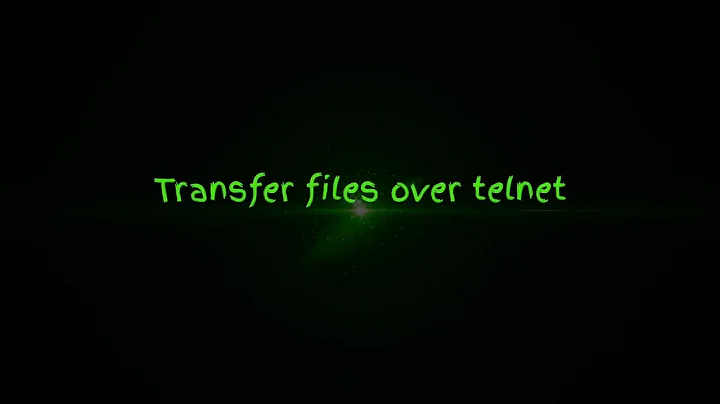Feeding contents of a text file as command to telnet
Solution 1
Use netcat (nc command) rather then "telnet", so
cat request.txt | nc docs.python.org 80
Telnet is a quick and easy hack, but netcat is, apparently, the correct tool for the job.
Solution 2
I don't really have any experience with telnet but it does take input from file redirection:
telnet < abc.txt
I can get it to connect to the server correctly as follows:
$ cat abc.txt
open docs.python.org 80
$ telnet < abc.txt
telnet> Trying 82.94.164.162...
Connected to dinsdale.python.org.
Escape character is '^]'.
Connection closed by foreign host.
Perhaps you can figure out how to get it to accept the GET command but I couldn't. An alternative is to use an expect script:
#!/usr/bin/expect
spawn telnet docs.python.org 80
expect "Escape character is '^]'." {
send "GET /2/license.html HTTP/1.1\nHost: docs.python.org\n\n"
}
interact
You can then save the script as telnet.exp,make it executable and run it:
./telnet.exp > output.html
Related videos on Youtube
Bentley4
Profile with mostly old questions where I learned about programming. Thank you SO!
Updated on September 18, 2022Comments
-
 Bentley4 almost 2 years
Bentley4 almost 2 yearsWith the command
telnet docs.python.org 80, I can do a manual HTTP request tohttp://docs.python.org/2/license.html, by typing the actual request.Now, instead of typing it in live, I'd like to feed the request from a text file.
I tried this:
cat request.txt|telnet docs.python.org 80
request.txt:
GET /2/license.html HTTP/1.1 Host: docs.python.org
(You have to finish the file with a blank line or you'll get a bad request!)
But the connection to the server is closed immediately.
How should I properly pipe request.txt to
telnet docs.python.org 80?
edit:
It's good to know; if you use
HEADinstead ofGET, you will get the same response as if you did aGETrequest, except for the message body.
So, useHEADif you just want to examine the HTTP headers. (i.e. So that the contents of the response doesn't clutter your shell output.)-
 terdon over 10 yearsCould you include the actual command you run manually so we can compare? When I run the
terdon over 10 yearsCould you include the actual command you run manually so we can compare? When I run theGETyou have posted, I get a408 Request Time-outerror. Also, iswget http://docs.python.org/2/license.htmlnot an option? -
 Bentley4 over 10 yearsThe commands are correct. I think you are making a connection with the server the moment you enter
Bentley4 over 10 yearsThe commands are correct. I think you are making a connection with the server the moment you entertelnet docs.python.org 80, so you 'll have to hurry and type in those two lines(copy paste if necc.) within a few seconds or the server will return a time-out error. -
 Bentley4 over 10 yearsI think the reason why you need to type
Bentley4 over 10 yearsI think the reason why you need to type<ENTER>a second time at the end is because the HTTP protocol requires an extra empty line after the request headers. See the request message section of the HTTP wiki article -
 Bentley4 over 10 years@ the
Bentley4 over 10 years@ thewgetsolution: I want to define my request manually, with headers and all. That line in wget you proposed defines headers and message body automatically. -
 terdon over 10 yearsDammit, theoretically, you should be able to do
terdon over 10 yearsDammit, theoretically, you should be able to dotelnet < request.txtbut I can't get theGETcommand to work. -
 voices about 8 years@Bentley4 You actually type
voices about 8 years@Bentley4 You actually type<ENTER>?
-
-
 Bentley4 over 10 yearsCool, I didn't know of
Bentley4 over 10 yearsCool, I didn't know ofexpect! I chose davidgo's answer because it is just the best solution for this case. I don't see any usage difference between netcap and telnet for what I wanted to achieve. Thanks for the effort nonetheless Terdon, if I could upvote your answer more, I would. -
 terdon over 10 years@Bentley4 no problem, using
terdon over 10 years@Bentley4 no problem, usingncis the better solution, you should accept it. -
davidgo over 10 yearsCertainly not for this case, but I think people (read Me, and apparently you !!!) tend to use telnet because its the first thing we learnt, and, of-course, its available on Windows and Linux, where I believe netcat does not come pre-installed under Windows.
-
2rs2ts over 8 yearsI fail to see how
interactis the right way to end thatexpectscript. -
 terdon over 8 years@2rs2ts I know very little about expect, you might be right but I can't tell since your comment didn't tell me why you think it's wrong. My understanding is that
terdon over 8 years@2rs2ts I know very little about expect, you might be right but I can't tell since your comment didn't tell me why you think it's wrong. My understanding is thatinteract"gives control of the current process to the user, so that keystrokes are sent to the current process, and the stdout and stderr of the current process are returned" (that's fromman expect). So,interactis the way to give the user a way of actually using the telnet connection. -
2rs2ts over 8 yearsSince the original question was about feeding the contents of a file into
telnetrather than interacting with it I think you should end withclose -i $spawn_idor something like that. Then the script will exit. WithinteractI was actually unable to exittelnetat all, and had to close my terminal. Pretty miserable (although it may have been partially my fault.) -
 terdon over 8 years@2rs2ts ah, I see. Yes, that was intentional since I assumed the OP would want to interact with the telnet shell. Ctrl+D or
terdon over 8 years@2rs2ts ah, I see. Yes, that was intentional since I assumed the OP would want to interact with the telnet shell. Ctrl+D orexitshould let you exit it. -
2rs2ts over 8 yearsYeah, that's the thing, I actually couldn't get out with the EOF. Can't remember if I tried
exit, probably not. -
 terdon over 8 years@2rs2ts OK, good to know. It's very late here so you m nor up for testing this but I'll try and check tomorrow. In the meantime, feel free to edit the answer and either change the code or add a warning or whatever you feel is best. Thanks for the heads up.
terdon over 8 years@2rs2ts OK, good to know. It's very late here so you m nor up for testing this but I'll try and check tomorrow. In the meantime, feel free to edit the answer and either change the code or add a warning or whatever you feel is best. Thanks for the heads up.




